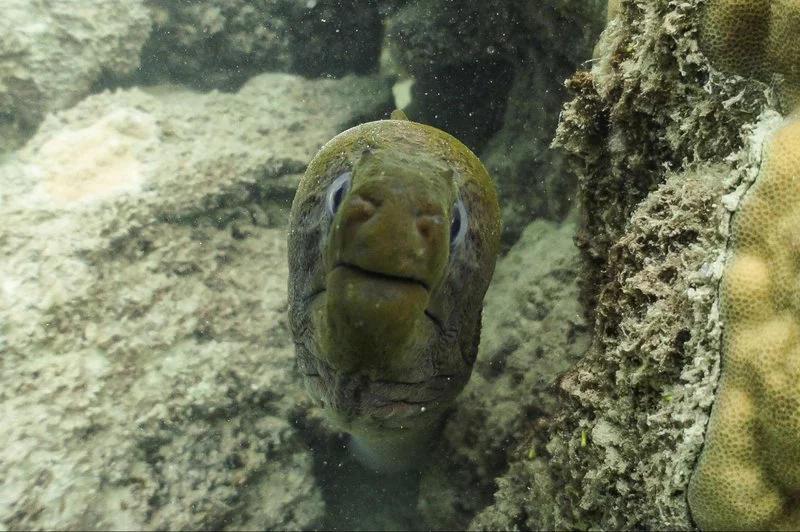Moray eels are part of a family called Muraenidae which has around 200 different species. Although eels physically look more like snakes they are actually a type of fish. Although unlike most bony fish morays do not have scales, their skin is smooth and covered in a thick mucus layer which in some species is toxic. They often sit with their mouths open showing off their razor sharp teeth, this makes them look quite fearsome and dangerous, a bit like they want to attack. However there is nothing to be afraid of as they are just breathing, water is pumped in through their open mouths and then pushed out over their gills. This does not mean that they won’t bite at all though so fingers and hands should be kept well clear as they can attack in a flash if they feel threatened or mistake your fingers for a tasty snack.
These snake like fish can be found in both marine and fresh waters worldwide but are most common in tropical and temperate marine waters. The eels will occupy a range of different habitats from shallow tropical coral reefs to deeper benthic and mesopelagic zones at depths over 200 meters. They are commonly found using holes, cracks and crevices in coral reefs, rocky reefs and even ship wrecks as shelter rarely fully exposing themselves which they usually only do to move to their next hiding spot.
All morays have a long slender snake like body with a dorsal fin which runs its whole length. Depending on species some of these fish can reach up to 3 meters long when fully grown. They also have quite large jaws filled with a haphazard set of sharp needle-like teeth. This is not the only set of jaws they have though. Morays have what is known as a pharyngeal jaw, this is a second set of jaws located further back in the eels throat (pharynx). Once the eel has bitten down on the prey the pharyngeal jaw is brought forward bites down and then retracts pulling the prey down with it.
Moray eels have similar reproductive cycles and mating behaviours as other bony fishes. They are oviparous which means they lay eggs, fertilisation of these eggs occurs outside of the female in the water column. The male and female will entertain and the female will release up to 10,000 eggs and at the same time the male will release the sperm. Once the eggs have been fertilised they will be carried around by the oceans currents as zooplankton while eggs hatch and the larvae develop. Moray eel larvae look like smaller transparent versions of the adult eels. Once they are fully developed they will swim down to a suitable reef or other structure and begin their lives as an adult.
The main food source of moray eels is smaller fish, molluscs (like squid and octopus) and crustaceans (Crabs and crayfish). They are opportunistic ambush predators which means that they do not usually actively hunt prey, they sit and wait for something to swim past at a close enough range and then pounce. Eyesight is not their strong point, eels actually have quite poor vision and rely on chemoreception , they can detect chemical changes in the water which can indicate the approach of something to eat. They also have quite a strong sense of smell due to their large tube like nostrils. In return moray eels are not preyed on very often. Some of the few predators they have are sharks, groupers and barracuda. Although interestingly moray eels and groupers have been observed working together to hunt and trap smaller fish.
As the Whitsunday region has a tropical climate it is the perfect place for moray eels to settle. Our fringing reefs also provide them with ample hiding spots and abundant food sources. On your next snorkel be sure to check in all the little caves, crevices and cracks on the reef to see if you can spot one of these snake like beauties for yourself.

